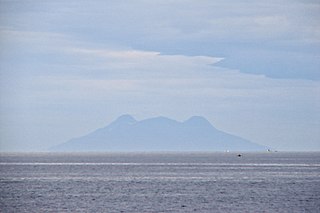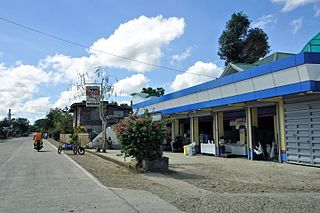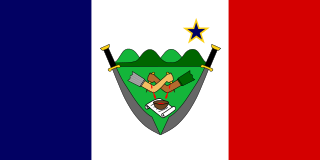Related Research Articles

The Visayas, or the Visayan Islands, are one of the three principal geographical divisions of the Philippines, along with Luzon and Mindanao. Located in the central part of the archipelago, it consists of several islands, primarily surrounding the Visayan Sea, although the Visayas are also considered the northeast extremity of the entire Sulu Sea. Its inhabitants are predominantly the Visayan peoples.
The military history of the Philippines is characterized by wars between Philippine kingdoms and its neighbors in the precolonial era and then a period of struggle against colonial powers such as Spain and the United States, occupation by the Empire of Japan during World War II and participation in Asian conflicts post-World War II such as the Korean War and the Vietnam War. The Philippines has also battled a communist insurgency and a secessionist movement by Muslims in the southern portion of the country.

Bohol, officially the Province of Bohol, is an island province of the Philippines located in the Central Visayas region, consisting of the island itself and 75 minor surrounding islands. Its capital is Tagbilaran. With a land area of 4,821 km2 (1,861 sq mi) and a coastline 261 km (162 mi) long, Bohol is the tenth largest island of the Philippines.

The Bohol Sea, also called the Mindanao Sea, is located between the Visayas and Mindanao islands in the Philippines. It lies south of Bohol and Leyte and north of Mindanao. Siquijor and Camiguin are its two major islands.
Battle of the Philippines may refer to several wars, military campaigns, and major battles which have been fought in the Philippine Islands, including:

Balilihan, officially the Municipality of Balilihan, is a 4th class municipality in the province of Bohol, Philippines. According to the 2020 census, it has a population of 18,694 people.

Cortes, officially the Municipality of Cortes, is a 5th class municipality in the province of Bohol, Philippines. According to the 2020 census, it has a population of 18,344 people.

Danao, officially the Municipality of Danao, is a 4th class municipality in the province of Bohol, Philippines. According to the 2020 census, it has a population of 20,245 people.

Guindulman, officially the Municipality of Guindulman, is a 4th class municipality in the province of Bohol, Philippines. According to the 2020 census, it has a population of 34,104 people.

Inabanga, officially the Municipality of Inabanga, is a 3rd class municipality in the province of Bohol, Philippines. According to the 2020 census, it has a population of 48,534 people.

Mabini, officially the Municipality of Mabini, is a 4th class municipality in the province of Bohol, Philippines. According to the 2020 census, it has a population of 28,701 people.

Talibon, officially the Municipality of Talibon, is a 1st class municipality in the province of Bohol, Philippines. According to the 2020 census, it has a population of 71,272 people.

Francisco Dagohoy was a Filipino revolutionary who holds the distinction of having initiated the longest revolt in Philippine history, the Dagohoy Rebellion. This rebellion against the Spanish colonial government took place on the island of Bohol from 1744 to 1829, roughly 85 years. Francisco Dagohoy started the revolt at the age of 20. He probably died before 1829 due to either old age or sickness.

During the Spanish colonial period in the Philippines, 1521–1898, there were several revolts against the Spanish colonial government by indigenous Moro, Lumad, Indians, Chinese (Sangleys), and Insulares, often with the goal of re-establishing the rights and powers that had traditionally belonged to Lumad Timueys, Maginoo Rajah, and Moro Datus. Some revolts stemmed from land problems and this was largely the cause of the insurrections that transpired in the agricultural provinces of Batangas, Bulacan, Cavite, and Laguna. Natives also rebelled over unjust taxation and forced labor.
The Dagohoy rebellion, also known as the Dagohoy revolution and the Dagohoy revolt, is considered as the longest rebellion in Philippine history. Led by Francisco Dagohoy, or Francisco Sendrijas, the rebellion took place on the island of Bohol from 1744 to 1829, lasting for roughly 85 years.

Tamblot was the name given to a babaylan who incited a series of uprisings against Spanish colonial rule in the island of Bohol. Indigenous religions and beliefs played a huge part behind the revolts' inception as Roman Catholicism spread throughout the Philippine archipelago, a process which many of its inhabitants rejected in favor of their local customs. A few uprisings in the early colonial era such as this one were thus motivated in part by resistance against the presence of Christianity.

The Flag of Bohol is the provincial flag of Bohol, Philippines. It is a vertical triband bearing the three main colors of the Philippine flag. According to the official interpretation of the flag's symbolism, the color blue represents nobility; white, purity; and red, courage. The design is similar to the flags of France and the Novgorod Oblast in Russia.

The Federal State of the Visayas was a revolutionary state in the Philippine archipelago during the revolutionary period. It was a proposed administrative unit of a Philippines under a federal form of government.
Anarchism in the Philippines has its roots in the anti-colonial struggle against the Spanish Empire, becoming influential in the Philippine Revolution and the country's early trade unionist movement. After being supplanted by Marxism-Leninism as the leading revolutionary tendency during the mid-20th century, it experienced a resurgence as part of the punk subculture, following the fragmentation of the Communist Party of the Philippines.
References
- ↑ "Abatan River Cruise: A travel through history". Bohol Chronicle. Archived from the original on 28 September 2007.